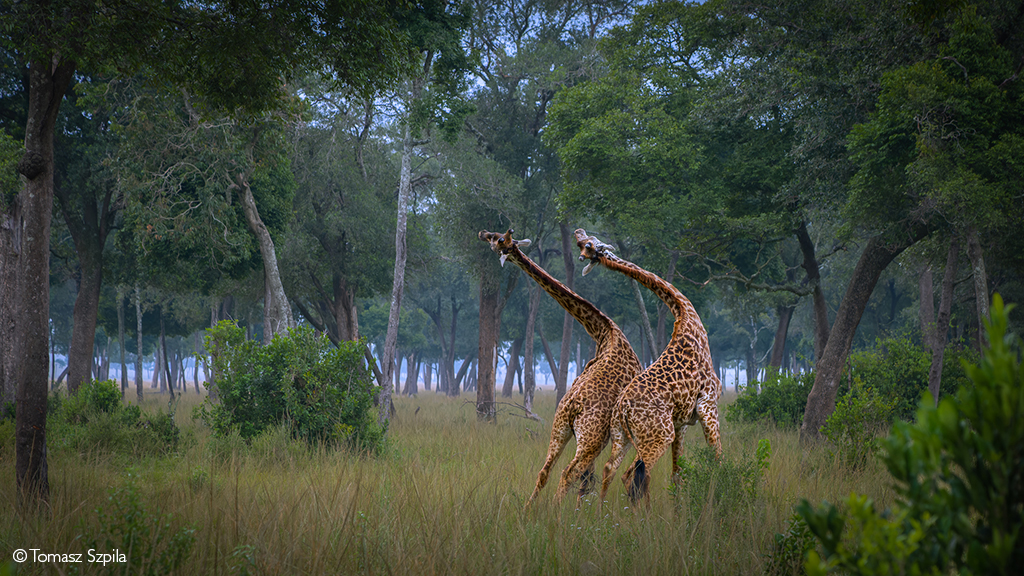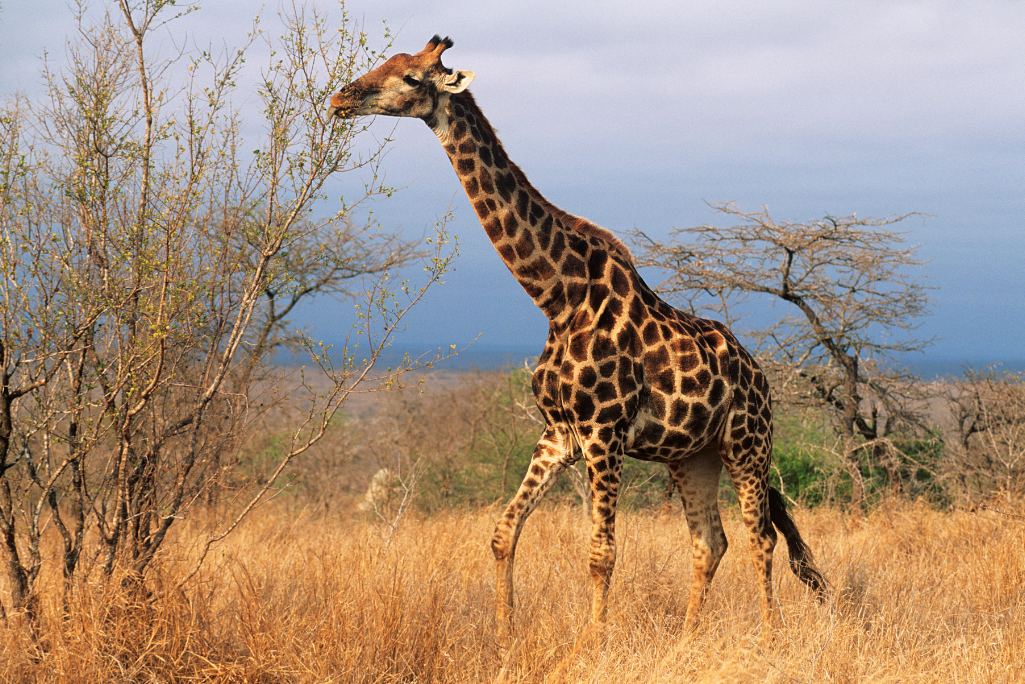 Did giraffes evolve their iconic long necks for sex or food? A new study explores whether these majestic features evolved more for foraging or mating, offering fresh insights into giraffe evolution.
Did giraffes evolve their iconic long necks for sex or food? A new study explores whether these majestic features evolved more for foraging or mating, offering fresh insights into giraffe evolution.
Giraffes are among the most iconic and instantly recognisable animals on the planet, thanks to their extraordinarily long necks. Towering over Africa’s savannah, these majestic creatures can reach heights of up to 5.5 metres, with their necks alone accounting for about 1.8 metres of that stature. But why did giraffes evolve such a unique and seemingly cumbersome feature? This question has fascinated curious minds for centuries.
For many years, scientists argued that giraffes’ elongated necks developed due to the environmental pressures of browsing for food high in the tree canopy. Early evolutionary biologists like Jean-Baptiste Lamarck and Charles Darwin proposed that this adaptation allowed giraffes to minimise competition with other herbivores by accessing leaves that were unreachable to most.
Others suggested that giraffes developed long necks for competition related to mating, as male giraffes often engage in aggressive necking interactions to assert social dominance within their breeding herds. These neck sparring matches provided an advantage to males with longer and stronger necks, leading to more reproductive success over different generations.
Neither side of the camp was wrong because the future of a species will always depend on food for survival and sex to continue the species, but what was the most important factor in the evolution of their long necks? The necks-for-sex hypothesis always overshadowed the hypothesis that they developed long necks for nutritional purposes.
A team of biologists from Penn State University in Pennsylvania is adding to the debate with some new findings published in the journal Mammalian Biology. To come to their conclusions, they studied Masai giraffes (Giraffa tippelskirchi) in captivity and the Tanzanian wilderness.


One interesting finding arising from the study showed that, surprisingly, female giraffes have proportionally longer necks than males. They indicated that the female giraffe’s longer necks might allow them to access difficult-to-reach leaves deeper in the crowns of trees, to satisfy higher nutritional demands. A longer neck could give females an edge in finding sufficient nutrients during pregnancy and lactation, making longer necks a feature crucial for successfully carrying and nursing their young. Differing nutritional requirements between males and females mean that they feed at different points in the tree.
“Males and females will browse at all heights, but females predominately feed at lower heights, and males higher. Note that this is not just because males are taller; males hold their necks closer to perpendicular whereas females will typically feed holding their necks near horizontal,” explains Douglas Cavener, Distinguished Chair in Evolutionary Genetics at Penn State University.

Their study also revealed how the proportional lengths of a giraffe’s neck, legs, and torso differ between males and females. Male and female giraffes look almost identical at birth. Their neck length, leg length, and other proportions are very similar in the first few years of life. However, as they age, their body shapes start to diverge based on their sex.
The study found that male giraffes develop proportionally longer forelegs compared to their hind legs and trunks than females. This may be connected to their behaviours of leg kicking, and foreleg pushes used in physical fights with other males. Longer front legs could help males push with more force in competitions for dominance and access to mates.

This was an unexpected find, even for those involved in the study. “I was surprised to see that females have proportionally longer necks. I was also surprised that other body components, including the trunk, neck thickness, and foreleg lengths, showed sexual dimorphisms in body proportions,” explained Cavener. He said it was surprising that none of these differences existed in newborn calves. It takes almost three years to start seeing these differences between the sexes.
How do you conduct a study like this without capturing giraffes and using a measuring tape? Researchers collected over 350 images of Masai giraffes from North American zoos, and giraffes in the wild. Some giraffes were photographed multiple times at different ages, allowing analysis of body proportion changes. Only those where giraffes stood perpendicular to the camera were useful.
 Want to see giraffes while on safari in Africa? Check out our selection of ready-made safaris here, or let our travel experts plan the perfect African safari for you by clicking here
Want to see giraffes while on safari in Africa? Check out our selection of ready-made safaris here, or let our travel experts plan the perfect African safari for you by clicking here
Since it is challenging to establish exact measurements such as total height from a photograph without a known reference point, the researchers concentrated on relative measurements or body proportions, like the neck length compared to the animal’s overall height.
They also knew the ages of the captive giraffes, which allowed them to analyse proportion changes from birth to maturity. They estimated wild giraffe ages but only used giraffes over a certain age. Statistical modelling then revealed age-related sexual dimorphism patterns, validated by similarities in both captive and wild populations.
The Masai giraffes studied within North American zoos and parks can trace their ancestry to a founding population-based in southeastern Kenya and northeastern Tanzania. This original group lived east of the cliffs formed by the Gregory Rift Valley, a notable geological feature of the region.

In 2023, scientists from the same university classified these giraffes as a subpopulation known as Eastern Masai giraffes. Comparing the captive and wild subgroups provided valuable data for the study, as their ancestral origins overlap within the geographic borders of East Africa.
While competition among males and female preference for larger mates may have driven the size differences between the sexes, the study’s conclusion sheds light on how neck length evolved due to the foraging needs of female giraffes. And with habitat loss and poaching leading to a declining giraffe gene pool, innovative conservation solutions that factor in ecology and genetics are more important than ever.
Further giraffe reading
- The giraffe is a wonder of evolution, and a vital part of Africa’s ecosystems. Read all there is to know about the planet’s tallest creature here.
- Do giraffes choose their social groups based on appearance? A recent study investigates if giraffes form bonds based on spot shape – Read more about how giraffes choose their besties here
- Towering intellect: Read how scientists discovered that giraffe can use statistical reasoning here
- Giraffe social structure is as complex as elephants’ – consisting of intricate communication, stable kinship groups and supportive mothering. Read more here.
- Under pressure – genetic research on giraffes reveals evolutionary secrets of how they cope with high blood pressure and maintain bone density. Read more about giraffe evolution here.
Reference
Cavener, D.R., Bond, M.L., Wu-Cavener, L. et al. Sexual dimorphisms in body proportions of Masai giraffes and the evolution of the giraffe’s neck. Mamm Biol (2024).
To comment on this story: Login (or sign up) to our app here - it's a troll-free safe place 🙂.![]()






